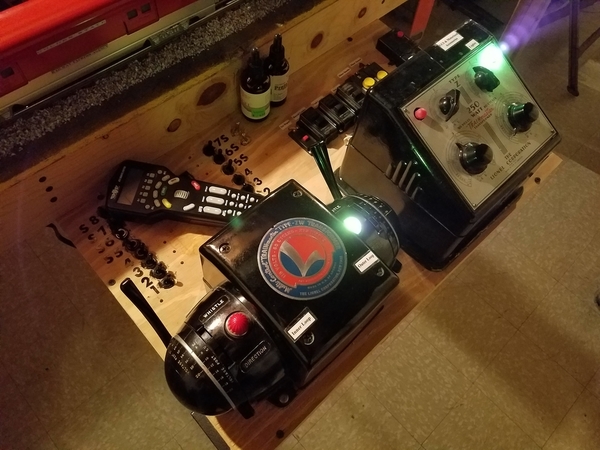I just purchased remote/TIU (revision L) combination, brand new, from a hobby shop. The TIU is powered through the aux port by a 12 v, 2 amp transformer. Track power is supplied by a Postwar ZW, with throttle A powering variable 2 and throttle D powering variable 1. Both A & D have TVS diodes and a 10 amp circuit breaker on the power wires going into the TIU. Variable 1 powers one loop of track, variable 2 powers another. All layout wiring is 14 gauge. Each loop is divided into 8 blocks, each with its own power feed. Grounds are common and tied together.
I have run two Premier steam locomotives on DCS (one on each separate loop) with no issues. I just turn variable 1 and variable 2 up to 20 volts and run the locomotives via DCS. Everything works fine. Today I tried to run a conventional train, one on each loop, and the trains acted weird. One loop had a conventional Lionel GP9 with a Pullmor motor and Railsounds 2.5 pulling 12 boxcars and a caboose. The other loop had a Williams Alco PA (motors wired in series) with ERR Alco PA Railsounds pulling 6 aluminum passenger cars.
Here's where it got weird. I started the GP9 and boxcar train on variable 1 first. I got the train rolling along at 14 volts on the DCS remote. It was running fine. I then started the train lead by the PA on the track controlled by variable 2. It too ran fine at 18 volts indicated on the DCS remote. I nudged the voltage on variable 2 up to 19 volts. All of a sudden the horns on both locomotives (on two separate TIU channels and two separate tracks) started blowing. The GP9's horn would blow continuously, the PAs horn would chirp. At the same time I noticed that the lights on both trains were varying in intensity, almost as if voltage was bouncing up and down. I turned the voltage down on variable 2 to 18.5 volts and the pulsing lights and horns stopped. Turn it back up to 19 volts and it started again. I stopped both trains and replaced the Williams PAs with a Lionel 2343 F3 and Railsounds 2.5 F3 B unit. I started both trains up. I set the train led by the GP9 on variable 1 to 14 volts and then brought the train now led by the Lionel F3 on variable 2 up to 18 volts. Everything was fine. I then scrolled to 18.5, 19, 19.5, and 20 volts on variable 2. No issues with lights pulsing or horns constantly blowing. Everything was fine.
So my question is how is the Williams PA with the ERR sound commander causing this weird behavior? Is it the series wiring of the motors? I can't figure how it would cause the horns to blow on two separate TIU channels above 18.5 volts on the DCS remote. Is having the two commons tied together causing some weird feedback?
Edit: As a side note both locomotives/trains operate fine at the same time when controlled conventionally with the A and D handles of the ZW transformer (so no TIU in the equation).










